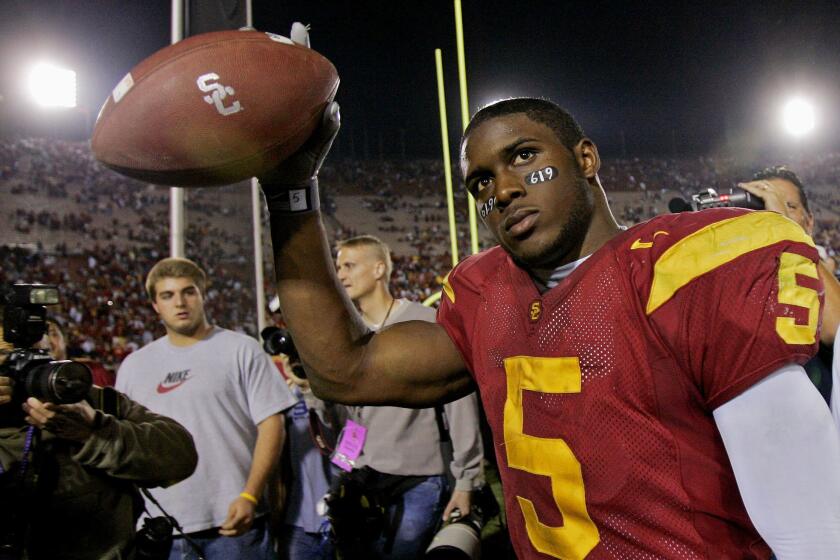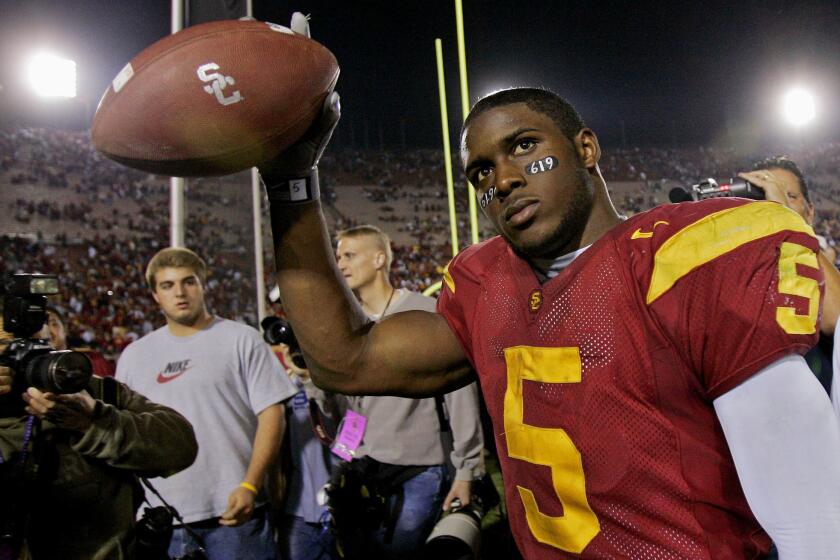Balancing grades and gridiron
NBC recently renewed its television contract with Notre Dame football through the 2015 season, betting the bank that the Irish, who have not won a national championship since 1988 or a bowl game since 1993, can consistently deliver television ratings that keep corporate sponsors happy and revenue streams flowing.
Notre Dame’s attempt to return to glory raises a fundamental question: Can the nation’s top-25 academic institutions -- Stanford, Duke, Northwestern, Notre Dame, Vanderbilt and Michigan are examples -- successfully compete in the world of corporate college football without substantially compromising academic standards?
California’s Division I schools suggest that the answer is no. Football players at USC, UCLA and UC Berkeley perform well on the field while struggling in the classroom. Stanford’s players excel academically, but the team hasn’t had a winning season since 2001. Notre Dame, however, is betting that it’s still possible to field successful student athletes.
Although Notre Dame cuts football players a break in regard to admissions, its relatively high 79% federal graduation rate (FGR) -- the best measure of whether recruited athletes fit a school’s academic profile -- indicates that the university recruits athletes who actually are likely to graduate from Notre Dame. The average FGR for last year’s top 25 Football Bowl Subdivision teams was about 50%. Louisiana State University, the 2007 national champion, graduated 38% of its players; runner-up Ohio State University graduated 48%. (California’s football powerhouses produce mediocre results at best, with USC at 54%, UCLA at 51% and UC Berkeley at 44%.)
Despite Notre Dame’s success during Coach Charlie Weis’ first two seasons -- 2005 and 2006 -- the Irish took a pounding in 2007, ending the season with a 3-9 record. Perennial powers such as LSU and the universities of Georgia, Florida and Oklahoma, on the other hand, have teams with graduation rates in the 35% range. Notre Dame endured a crushing loss to LSU in the 2007 Sugar Bowl.
These data suggest that schools that hold their ground on academic standards for athletes may be at a disadvantage in college sport’s recruiting wars. Is it merely coincidence that Stanford and Duke, two of the teams the Irish were able to beat in 2007, have football graduation rates over 90%? The National Collegiate Athletic Assn. no longer discloses the average standardized test scores of various football teams. But would anyone be surprised to find that test scores, like federal graduation rates, correlate negatively with gridiron success?
The NCAA has recently introduced a system that allows a recruited athlete to offset an extremely low standardized test score with a high grade point average in high school. A blue-chip athlete with a low combined SAT score and a B average in high school core courses would be NCAA-eligible. Some major football powers accept such students before even running the decision past university admissions. This would not be an option at Stanford, Duke or Notre Dame.
As the battle over TV dollars and exposure has reached an all-time high, many schools are using “special admits” -- students accepted even though their grades and test scores do not fit the overall student profile -- to get an edge. Coach Steve Spurrier of the University of South Carolina recently threatened to resign when several football recruits were turned down by the admissions office. Spurrier is probably not alone in thinking that NCAA minimums should override a university’s admissions policy.
Notre Dame is at a crossroads. Even though the football team’s average SAT score (about 1050) falls below the university average, it soars hundreds of points above the NCAA’s allowable minimum. High graduation rates, an athletic counseling director who reports directly to the provost, a stadium without skyboxes or corporate signage, and no games on regular weeknights -- these are just a few of the outward signs that Notre Dame retains a focus on education.
Whether the Irish can retain that focus and consistently compete in college football’s upper echelon remains an open question, and one that is relevant to all universities that place a premium on academic excellence. If Notre Dame manages to return to glory without abandoning principles that have been its hallmark, those who support the claim that commercial sport and academic values can coexist will have scored some points.
Go beyond the scoreboard
Get the latest on L.A.'s teams in the daily Sports Report newsletter.
You may occasionally receive promotional content from the Los Angeles Times.



